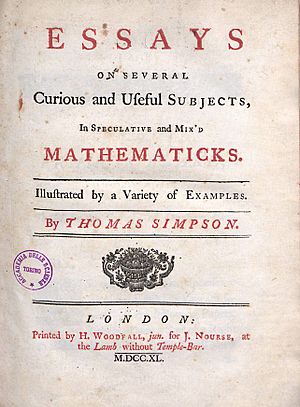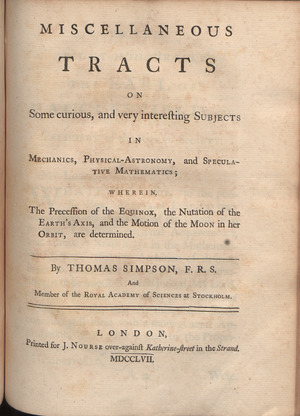Thomas Simpson facts for kids
Quick facts for kids
Thomas Simpson
|
|
|---|---|
| Born | 20 August 1710 |
| Died | 14 May 1761 (aged 50) |
| Known for | Simpson's rule Simpson–Weber triangle problem |
Thomas Simpson (born August 20, 1710 – died May 14, 1761) was a British mathematician. He was also an inventor. He is famous for something called Simpson's rule. This rule helps to estimate areas under curves in math. Even though the rule is named after him, other mathematicians like Johannes Kepler had found it earlier.
Contents
Life of Thomas Simpson
Thomas Simpson was born in Sutton Cheney, Leicestershire, England. His father was a weaver. Thomas taught himself mathematics. He became very good at it.
When he was about 25 years old, he moved to London with his family. He worked as a weaver during the day. At night, he taught mathematics to support his family.
In 1743, he started teaching math at the Royal Military Academy, Woolwich. This was a big achievement for him. He also became a member of the Royal Society. This is a group for important scientists. In 1758, he was also chosen as a member of the Royal Swedish Academy of Sciences.
Thomas Simpson passed away in Market Bosworth. He was buried in his hometown of Sutton Cheney. There is a special plaque in the church there to remember him.
Simpson's Rule in Mathematics
The method known as Simpson's Rule helps us estimate the area under a curve. Imagine you have a graph, and you want to find the exact area of a shape under a curved line. Simpson's Rule gives you a way to get a very close estimate.
Mathematicians like Bonaventura Cavalieri and James Gregory knew about this method before Simpson. However, many people learned it from Simpson's popular textbooks. That is why it is often called "Simpson's Rule."
The Simpson-Weber Triangle Problem
Thomas Simpson also worked on a problem related to finding the best location. This problem is now called the Simpson-Weber triangle problem. Imagine you have three different places, like three towns (A, B, and C). You need to find a new spot (D) that is the best location for something, like a factory. The goal is to make the total transportation cost from the factory (D) to the three towns (A, B, C) as low as possible.
This problem is about finding the point that minimizes the total distance or cost. It is a very early idea in the study of how places and economies are connected.
Later, in 1971, a mathematician named Luc-Normand Tellier found a direct way to solve this problem. He also created a new problem called the "attraction-repulsion problem" in 1985. This problem looks at how attractive and repulsive forces can balance out when choosing a location. These ideas helped lead to new ways of thinking about economic geography in the 1990s.
See also
 In Spanish: Thomas Simpson para niños
In Spanish: Thomas Simpson para niños
- Probability
- Series multisection
- Simpson's rules (ship stability)



